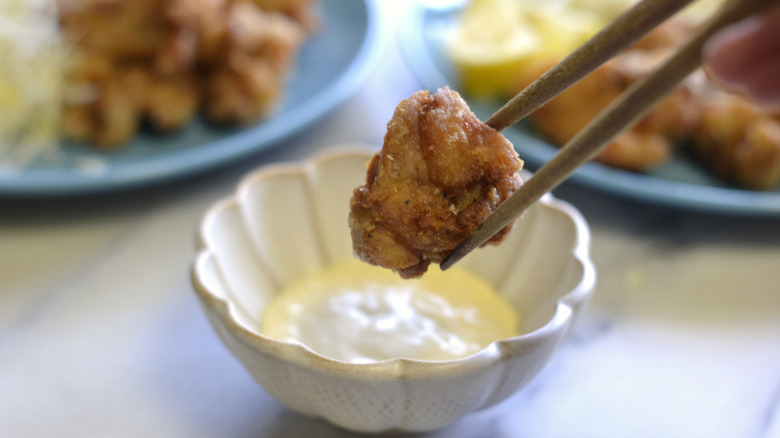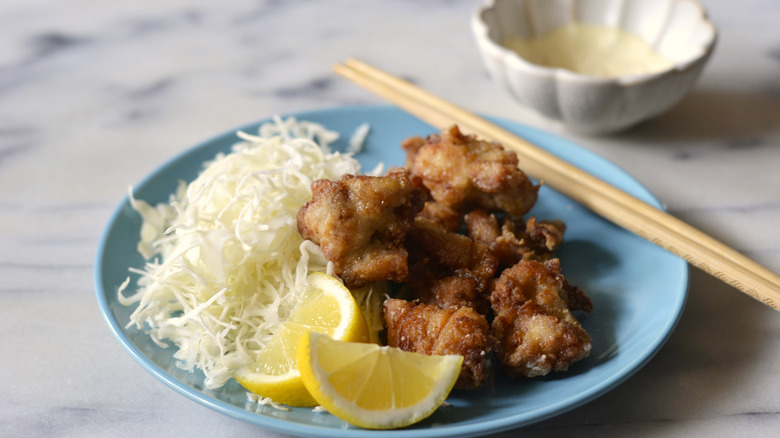Ginger Karaage Chicken Recipe
There's a reason why crunchy fried foods are so enjoyable. The textural sensation as you take a mouthful is a delight, and the contrast between the crispy exterior and whatever lies within is equally pleasant. Japanese karaage is a cooking method that consists of coating an ingredient in flour and deep frying it. Most commonly, you'll find flavorful pieces of juicy chicken encased inside the fried shell, and this ginger karaage chicken recipe is a prime example.
Recipe developer Rika Hoffman brings us this delicious recipe, which she pairs with a ginger mayo dipping sauce "for some extra zinginess." While there's a definite appeal to fried food, Hoffman agrees that it "can oftentimes be so heavy." However, she describes this recipe as "light and crisp and incredibly juicy — definitely worth the extra effort of deep-frying at home." Turn on your extractor fan and read on for all of the steps.
Gather the ingredients for this ginger karaage recipe
For this recipe, you'll want to use boneless skin-on chicken thighs for maximum flavor and minimal fuss. Next, you'll need grated ginger and garlic, soy sauce, cooking sake, sesame oil, salt, and black pepper to season. "An equal amount of mirin can be used in place of cooking sake," Hoffman suggests, and notes that it "contains less alcohol than cooking sake and has a higher sugar content, making it slightly more viscous and syrupy in texture."
The coating consists of equal parts all-purpose flour and potato starch. Hoffman explains that "The potato starch coating contributes to a light outer shell" and "performs better when frying at extremely high heat." Hoever, she notes that "Corn starch and tapioca starch work well as alternatives," although if you're using the former, "be mindful of the temperature and keep a close eye on the karaage's coloring to prevent burning." A neutral oil like canola or vegetable are ideal for frying since they can stand up to higher temperatures.
Next, the ginger mayo calls for Kewpie mayonnaise and more grated ginger. Finally, Hoffman likes to serve the crunchy karaage with Sriracha and lemon wedges.
Start by marinating the chicken
Start by prepping the chicken; cut the thighs into bite-sized pieces to make the eating experience extra enjoyable. In a small bowl, whisk together 2 heaping teaspoons of grated ginger, garlic, soy sauce, sake, sesame oil, salt, and pepper. Place the chicken pieces in a large bowl and pour the marinade over top. Mix the contents to properly coat the meat. Cover the bowl and transfer it to the fridge to marinate for a minimum of 1 hour.
Prepare the ginger mayo
While the chicken marinates, stir together the Kewpie mayo and 1 heaping tablespoon of grated ginger in a small bowl. Place the ginger mayo in the fridge until you're ready to serve. If you like a bit of heat, mix in a squirt of Sriracha sauce too.
Coat the chicken pieces
Once the chicken has been marinating for at least 1 hour, place a pot or skillet with a heavy bottom on the stovetop. Pour in enough oil to reach 1 inch in height and heat it while you coat the chicken.
Set out a large plate and pour the flour on one side and the potato starch on the other. One by one, coat every piece of chicken first with flour, followed by potato starch. To avoid a clumpy result, dust off any excess flour or potato starch before moving on to the next piece.
Fry the chicken in hot oil
Prep a wire rack with pieces of paper towel to absorb the extra oil from the fried chicken. Check to see if the oil is hot enough by dipping a wooden chopstick into the pot. If small bubbles start to form around it, you're good to go. If you have a thermometer (which is ideal), check for a temperature of around 325 F.
Add a few pieces of chicken at a time; Hoffman warns, "Try not to overcrowd the pan with too many pieces of chicken, which will drop the temperature." Fry the karaage for about 1 ½ minutes until it is a pale golden color, then transfer the pieces to the lined rack. Continue until you have fried all of the chicken.
Double fry each piece then serve
Hoffman explains that "double-frying ensures crispness," which sets this recipe apart from any ordinary fried chicken dish. To produce a perfect crust, you'll need to increase the temperature of the oil. If you're testing it with a thermometer, aim for 350 F. Transfer the chicken back to the oil in batches and fry it for another minute until the color deepens to a golden brown.
Don't wait around — serve the ginger karaage nice and hot with ginger mayo dipping sauce and freshly-squeezed lemon for a bit of tang. As for sides, Hoffman points out, "In Japan, karaage is commonly included in bento boxes [...] alongside rice and side dishes like Japanese potato salad and oshinko (pickled veggies)." She also recommends serving it with a miso-based soup or simply with "a frosty pint of beer or a classic whisky highball."
While we're pretty sure you'll gobble down every last piece, if you have any leftovers Hoffman instructs, "Let the karaage cool to room temperature before covering and storing it in the refrigerator for up to 3 days." When you're ready for more, reheat it for 3 to 5 minutes in a toaster oven or air fryer "to restore its crispness." Hoffman says, "It can also be zapped in the microwave if you don't mind a softer texture."
Ginger Karaage Chicken Recipe
Impress your friends with this perfectly crispy, twice-fried ginger karaage chicken recipe that will transport you straight to Japan.

Ingredients
- 1 pound boneless, skin-on chicken thighs
- 1 heaping tablespoon + 2 heaping teaspoons ginger, grated, divided
- 2 cloves garlic, grated
- 1 tablespoon soy sauce
- ½ tablespoon cooking sake
- 1 teaspoon sesame oil
- ¼ teaspoon salt
- ¼ teaspoon black pepper
- 3 tablespoons Kewpie mayonnaise
- 3 tablespoons all-purpose flour
- 3 tablespoons potato starch
- neutral oil (canola or vegetable), for frying
Optional Ingredients
- 1 tablespoon Sriracha
- lemon wedges, to serve
Directions
- Cut the chicken thighs into bite-sized pieces.
- Combine 2 teaspoons of grated ginger, grated garlic, soy sauce, cooking sake, sesame oil, salt, and pepper in a small bowl.
- Coat the chicken with the marinade in a large bowl and mix thoroughly by hand.
- Cover the chicken and let it marinate in the fridge for at least 1 hour.
- Mix the Kewpie mayo and 1 tablespoon of grated ginger in a bowl.
- Refrigerate the ginger mayo until ready to serve. (If desired, add a squeeze of Sriracha for spice.)
- Fill a heavy-bottomed pot or skillet 1 inch deep with neutral oil and heat.
- On a large plate, make a pile of all-purpose flour and another with potato starch.
- Coat each piece of marinated chicken first in the all-purpose flour, then in the potato starch, making sure to dust off the excess.
- Line a wire rack with a couple of pieces of paper towel to absorb excess oil from the fried karaage.
- Once the temperature reaches 325 F, the oil is ready for frying. (Test by inserting a wooden chopstick into the hot oil to see if it creates small bubbles.)
- Add 4 to 5 pieces of chicken at a time, being careful not to crowd the pan.
- Deep fry the karaage for about 1 ½ minutes or until it is a pale golden color before transferring it to the paper towel-lined wire rack.
- After all the chicken has been fried once, raise the oil temperature to 350 F for a second fry.
- Return each piece of chicken to the pan and fry for 1 minute or until the exterior is golden brown in color.
- Serve the ginger karaage hot with freshly-squeezed lemon and a side of ginger mayo.
Nutrition
| Calories per Serving | 1,166 |
| Total Fat | 100.7 g |
| Saturated Fat | 16.3 g |
| Trans Fat | 0.4 g |
| Cholesterol | 230.7 mg |
| Total Carbohydrates | 23.2 g |
| Dietary Fiber | 0.7 g |
| Total Sugars | 0.2 g |
| Sodium | 786.8 mg |
| Protein | 39.6 g |







